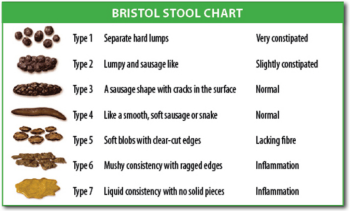Bristol stool scale: Difference between revisions
| [pending revision] | [pending revision] |
NawlinWiki (talk | contribs) m Reverted edits by I.eat.yangwei (talk) to last version by ClueBot NG |
No edit summary |
||
| Line 1: | Line 1: | ||
[[File:Bristol stool chart.svg|right|thumb|350px]] |
[[File:Bristol stool chart.svg|right|thumb|350px]] |
||
The '''Bristol Stool Scale''' or '''Bristol Stool Chart''' is a [[medical]] aid designed to classify the form of [[human |
The '''Bristol Stool Scale''' or '''Bristol Stool Chart''' is a [[medical]] aid designed to classify the form of [[human feces]] into seven categories. Sometimes referred to in the UK as the "Meyers Scale", it was developed by Dr. Ken Heaton at the [[University of Bristol]] and was first published in the ''Scandinavian Journal of Gastroenterology'' in 1997.<ref>{{cite journal |author=Lewis SJ, Heaton KW |title=Stool form scale as a useful guide to intestinal transit time |journal=Scand. J. Gastroenterol. |volume=32 |issue=9 |pages=920–4 |year=1997 |pmid=9299672 |doi=10.3109/00365529709011203}}</ref> The authors of that paper concluded that the form of the stool is a useful surrogate measure of [[colon (anatomy)|colon]] transit time. That conclusion has since been challenged as having limited validity, and only in types 1 and 2 when the subject is not constipated.<ref>{{cite journal |author=Rao SS, Camilleri M, Hasler WL, Maurer AH, Parkman HP, Saad R, Scott MS, Simren M, Soffer E, Szarka L. |title=Evaluation of gastrointestinal transit in clinical practice: position paper of the American and European Neurogastroenterology and Motility Societies. |journal=Neurogastroenterol Motil. |volume=23 |issue=1 |pages=8–23 |year=2011 |pmid=21138500}}</ref> However, it remains in use as a research tool to evaluate the effectiveness of treatments for various diseases of the bowel, as well as a clinical communication aid. |
||
The seven types of stool are: |
The seven types of stool are: |
||
Revision as of 08:02, 13 January 2012

The Bristol Stool Scale or Bristol Stool Chart is a medical aid designed to classify the form of human feces into seven categories. Sometimes referred to in the UK as the "Meyers Scale", it was developed by Dr. Ken Heaton at the University of Bristol and was first published in the Scandinavian Journal of Gastroenterology in 1997.[1] The authors of that paper concluded that the form of the stool is a useful surrogate measure of colon transit time. That conclusion has since been challenged as having limited validity, and only in types 1 and 2 when the subject is not constipated.[2] However, it remains in use as a research tool to evaluate the effectiveness of treatments for various diseases of the bowel, as well as a clinical communication aid.
The seven types of stool are:
- Type 1: Separate hard lumps, like nuts (hard to pass)
- Type 2: Sausage-shaped, but lumpy
- Type 3: Like a sausage but with cracks on its surface
- Type 4: Like a sausage or snake, smooth and soft
- Type 5: Soft blobs with clear cut edges (passed easily)
- Type 6: Fluffy pieces with ragged edges, a mushy stool
- Type 7: Watery, no solid pieces. Entirely liquid
Types 1 and 2 indicate constipation, with 3 and 4 being the "ideal stools", especially the latter, as they are the easiest to defecate, and 5–7 tending towards diarrhoea.
References
- ^ Lewis SJ, Heaton KW (1997). "Stool form scale as a useful guide to intestinal transit time". Scand. J. Gastroenterol. 32 (9): 920–4. doi:10.3109/00365529709011203. PMID 9299672.
- ^ Rao SS, Camilleri M, Hasler WL, Maurer AH, Parkman HP, Saad R, Scott MS, Simren M, Soffer E, Szarka L. (2011). "Evaluation of gastrointestinal transit in clinical practice: position paper of the American and European Neurogastroenterology and Motility Societies". Neurogastroenterol Motil. 23 (1): 8–23. PMID 21138500.
{{cite journal}}: CS1 maint: multiple names: authors list (link)
